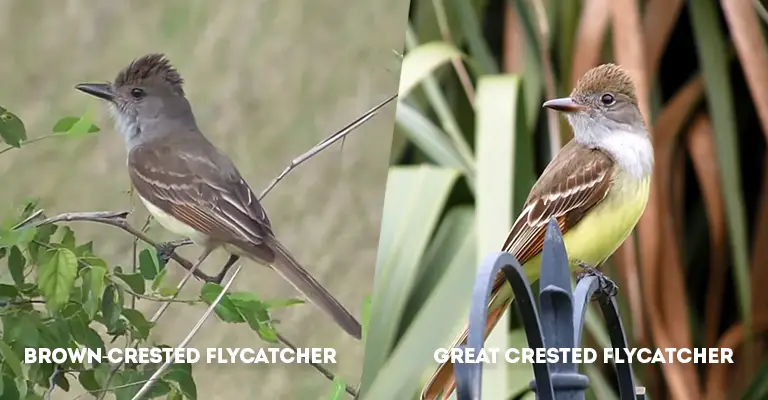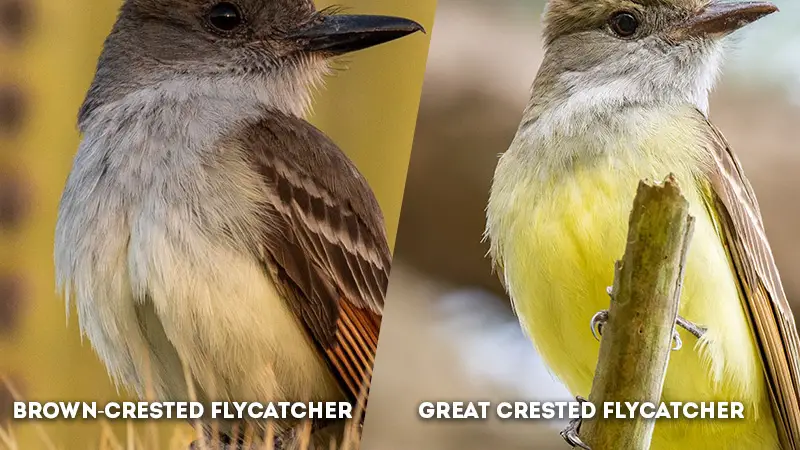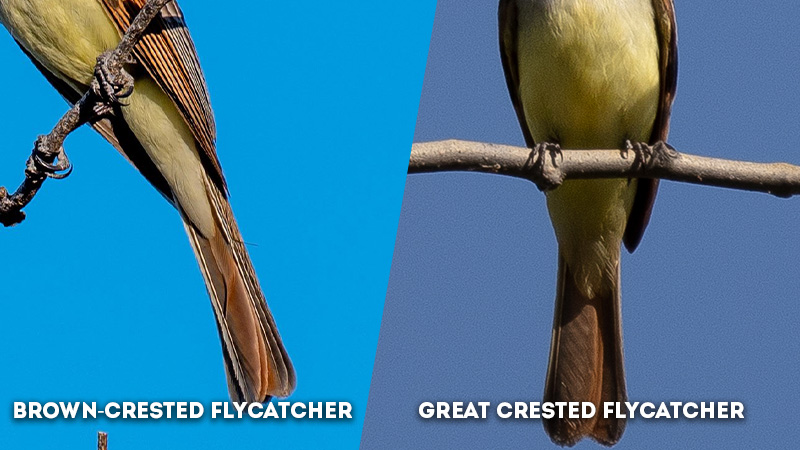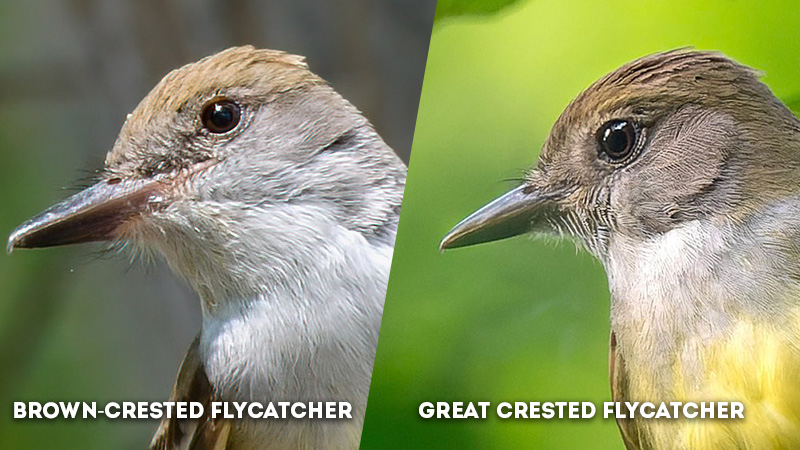The Brown-crested Flycatcher and the Great Crested Flycatcher are two distinct avian species that inhabit North and Central America. While they share the same genus, these flycatchers possess a range of unique characteristics that set them apart.
From subtle differences in plumage coloration to distinct behaviors, such as nesting habits and vocalizations, these birds offer an intriguing subject of comparison for bird enthusiasts and ornithologists alike.
Exploring their contrasts in wing bars, tail shapes, geographical ranges, migration behaviors, and other traits not only deepens our understanding of their ecology but also showcases the diverse adaptations that arise from their interactions with varying habitats and environments.

Key Differences Between Brown-crested Flycatcher and Great Crested Flycatcher
there are also key differences between brown-crested flycatchers vs great-crested flycatchers.
Here are some of the key differences:
Chest Color

- Brown-crested Flycatcher: The Brown-crested Flycatcher displays a chest with a paler gray hue. This coloration is subtle and lacks the vibrant contrast seen in its counterpart.
The gray shade on its chest is more muted, blending with its overall plumage. This understated color choice contributes to its overall appearance of subdued elegance. - Great Crested Flycatcher: In contrast, the Great Crested Flycatcher boasts a chest with vibrant and contrasting coloration. The chest exhibits a richer and more distinct hue, standing out prominently against its plumage.
The striking contrast between the chest color and the rest of the bird’s body contributes to its visually captivating appearance.
Belly Color
- Brown-crested Flycatcher: The Brown-crested Flycatcher exhibits a belly with a paler yellow hue. This subdued coloring gives the bird a more understated appearance, blending harmoniously with its overall plumage.
The paler yellow belly is a consistent feature in this species, contributing to its elegant and unassuming presence in its habitat. - Great Crested Flycatcher: Conversely, the Great Crested Flycatcher’s belly displays a vibrant and contrasting yellow coloration. The yellow stands out prominently against its plumage, creating a striking visual contrast.
This distinctive belly color is an eye-catching feature that adds to the bird’s overall allure and contributes to its recognizable appearance.
Tail Color (Below)

- Brown-crested Flycatcher: When viewed from below, the tail of the Brown-crested Flycatcher showcases a lesser extent of rufous-orange coloring.
The reddish-orange hues on the underside of the tail feathers are not as widespread, giving the bird a more muted tail appearance. This feature, although less prominent, contributes to the bird’s unique characteristics. - Great Crested Flycatcher: In contrast, the Great Crested Flycatcher’s tail, when seen from below, exhibits a more extensive rufous-orange coloring.
The reddish-orange hues cover a larger area of the tail feathers, creating a distinctive and visually appealing feature. This more pronounced tail coloring aids in identification and sets this species apart.
Crest Size
- Brown-crested Flycatcher: The crest of the Brown-crested Flycatcher is smaller in size compared to its counterpart. While still noticeable, the crest is not as prominent and striking as that of the Great Crested Flycatcher. This smaller crest adds to the bird’s overall modest and unassuming appearance.
- Great Crested Flycatcher: True to its name, the Great Crested Flycatcher boasts a larger and more impressive crest. The crest is a standout feature that can be raised and displayed when the bird is excited or agitated. This sizable crest contributes to the bird’s distinct profile and can catch the observer’s attention from a distance.
Eye Ring Color

- Brown-crested Flycatcher: The Brown-crested Flycatcher features an eye ring that is duller and less prominent. The coloring around the eye is more subdued and tends to blend with the bird’s overall facial plumage. This subtler eye ring contributes to the bird’s overall elegant and unobtrusive appearance.
- Great Crested Flycatcher: On the other hand, the Great Crested Flycatcher’s eye ring is characterized by its bright and prominent appearance.
The eye ring stands out distinctly around the eye, creating a visually striking feature on the bird’s face. This eye-catching eye ring contributes to the bird’s charismatic and captivating presence.
Throat Color
- Brown-crested Flycatcher: The Brown-crested Flycatcher showcases a throat with a lighter and less distinctive coloration. This lighter tone often blends more seamlessly with the surrounding plumage, contributing to the bird’s overall subdued appearance.
The throat color, while not a prominent feature, adds to the bird’s nuanced beauty. - Great Crested Flycatcher: In contrast, the Great Crested Flycatcher presents a throat with a deeper and more distinct color.
The color of the throat stands out more prominently against the rest of the plumage, creating a striking visual contrast. This distinct throat color adds to the bird’s captivating appearance.
Bill Color
- Brown-crested Flycatcher: The bill of the Brown-crested Flycatcher tends to be darker in color, often with a pale base.
This coloration provides a subtle yet distinctive feature to the bird’s facial profile. The darker bill, along with its specific shape, aids in identifying this species in the field. - Great Crested Flycatcher: On the other hand, the bill of the Great Crested Flycatcher is lighter in color, with a distinct dark tip.
This color contrast between the tip and the rest of the bill is a key feature for identification. The bill’s unique coloration contributes to the bird’s overall appearance.
Primary Call
- Brown-crested Flycatcher: The Brown-crested Flycatcher is known for its unique primary call, which is distinctive to this species.
This vocalization is an important identifier, often recognized by birdwatchers in the field. The call is part of the bird’s communication and contributes to its presence in its habitat. - Great Crested Flycatcher: The Great Crested Flycatcher is recognized for its loud and distinctive primary call.
This call is unique to the species and can be a strong indicator of its presence. The call’s volume and distinctiveness contribute to the bird’s communication and territorial behavior.
Secondary Calls
- Brown-crested Flycatcher: The Brown-crested Flycatcher exhibits a variety of secondary calls, including chatters and chirps.
These calls are used for different purposes, such as communication and interaction with other individuals. The diverse range of secondary calls adds depth to the bird’s vocal repertoire. - Great Crested Flycatcher: Similarly, the Great Crested Flycatcher is known for its wide array of calls, each serving a specific communication purpose.
These calls include clear and expressive vocalizations that contribute to the bird’s interactions within its habitat.
Habitat Preference
- Brown-crested Flycatcher: The Brown-crested Flycatcher tends to prefer arid and semi-open habitats. It is often found in areas with sparse vegetation, where it can use its flycatching behavior to catch insects on the wing. This habitat preference reflects the bird’s adaptation to specific environmental conditions.
- Great Crested Flycatcher: In contrast, the Great Crested Flycatcher favors wooded areas and forest edges as its habitat.
It is often found in more densely vegetated regions, using its unique foraging techniques to capture insects. This preference for wooded habitats distinguishes it from the Brown-crested Flycatcher.
Nesting Behavior
- Brown-crested Flycatcher: The Brown-crested Flycatcher often nests in tree cavities, utilizing pre-existing holes or natural crevices.
This behavior helps protect its eggs and nestlings from predators. It demonstrates adaptability in choosing suitable locations for nesting within its preferred habitat. - Great Crested Flycatcher: Contrastingly, the Great Crested Flycatcher frequently nests in natural or abandoned cavities, such as those created by woodpeckers or decayed portions of trees. This behavior showcases the bird’s resourcefulness in finding secure nesting sites.
Nesting Material
- Brown-crested Flycatcher: The Brown-crested Flycatcher constructs its nest using a mix of materials, including twigs, leaves, feathers, and grasses.
This assortment of materials contributes to the overall structure and insulation of the nest, providing a suitable environment for raising young. - Great Crested Flycatcher: Uniquely, the Great Crested Flycatcher incorporates snakeskins into its nest-building process.
These skins, shed by snakes, are wrapped around the interior of the nest. This behavior is believed to serve both a protective and potentially deceptive function.
Geographical Range
- Brown-crested Flycatcher: The Brown-crested Flycatcher’s geographical range encompasses the southwestern United States, and parts of Mexico, and extends into Central America. It has adapted to arid and semi-open habitats within this region.
- Great Crested Flycatcher: Conversely, the Great Crested Flycatcher’s range covers the eastern United States, portions of Canada, and Central America. Its distribution includes a wider expanse of wooded and forested areas compared to the Brown-crested Flycatcher.
Migration Behavior
- Brown-crested Flycatcher: The Brown-crested Flycatcher is typically a short-distance migrant, often moving within its range to find suitable breeding and wintering grounds. Its migration behavior is influenced by seasonal changes and the availability of resources.
- Great Crested Flycatcher: In contrast, the Great Crested Flycatcher is a long-distance migrant. It undertakes a more extensive journey between its breeding grounds in North America and its wintering areas in Central and South America. This behavior showcases the bird’s ability to navigate across significant distances.
Bill Shape
- Brown-crested Flycatcher: The bill of the Brown-crested Flycatcher features a slightly curved and pointed shape. This billing structure is adapted for its insect-catching behavior, allowing it to efficiently capture flying prey.
- Great Crested Flycatcher: The Great Crested Flycatcher’s bill is characterized by its straighter shape with a slightly hooked tip. This shape aids in grasping and manipulating prey items, showcasing the bird’s unique feeding strategy.
Wing Bars
- Brown-crested Flycatcher: The Brown-crested Flycatcher is characterized by pale wing bars that stand out against its plumage. These bars, located on the upper side of the wings, are relatively subtle but noticeable during flight.
The pale wing bars contribute to the bird’s distinctive wing pattern, aiding in its identification. - Great Crested Flycatcher: Conversely, the Great Crested Flycatcher exhibits bold and contrasting wing bars.
These bars are more prominent and easily discernible on the bird’s wings. The boldness of the wing bars is a notable feature that birdwatchers can use to differentiate this species.
Tail Shape
- Brown-crested Flycatcher: The Brown-crested Flycatcher possesses a squared tail shape. The tail feathers end relatively evenly, giving the tail a straight-edged appearance. This tail shape is a defining characteristic and contributes to the bird’s overall silhouette.
- Great Crested Flycatcher: In contrast, the Great Crested Flycatcher’s tail is slightly notched in shape. The tail feathers have a subtle indentation, creating a V-shaped appearance. This unique tail shape sets the species apart and can be observed during flight or perching.
Undertail Color
- Brown-crested Flycatcher: The undertail coverts of the Brown-crested Flycatcher display a paler coloration.
These feathers, located underneath the tail, exhibit a lighter shade compared to the rest of the bird’s plumage. This undertail color contributes to the bird’s nuanced appearance. - Great Crested Flycatcher: On the other hand, the Great Crested Flycatcher’s undertail coverts are darker in color.
The feathers underneath the tail exhibit a distinct contrast, creating a noticeable feature that can aid in identification, especially during observations from below.
Size
- Brown-crested Flycatcher: The Brown-crested Flycatcher is slightly smaller in size compared to the Great Crested Flycatcher.
This size difference is not drastic, but it can be discerned through careful observation. The bird’s smaller stature contributes to its overall unassuming presence. - Great Crested Flycatcher: In contrast, the Great Crested Flycatcher is slightly larger in size. This size difference is often perceptible when comparing the two species side by side. The larger size contributes to the bird’s more robust appearance.
Behavior
- Brown-crested Flycatcher: The Brown-crested Flycatcher displays a more solitary behavior compared to the Great Crested Flycatcher.
It is often seen foraging alone for insects and typically maintains a more independent approach to its activities. This behavior aligns with its preference for arid and semi-open habitats. - Great Crested Flycatcher: The Great Crested Flycatcher can exhibit more territorial and aggressive behavior, especially during the breeding season.
It can be vocal and assertive in defending its territory from intruders, which contributes to its dynamic presence in its habitat.
Brown-crested Flycatcher Vs Great Crested Flycatcher: Comparison Table
| Feature | Brown-crested Flycatcher | Great Crested Flycatcher |
|---|---|---|
| Chest Color | Paler gray | Vibrant and contrasting |
| Belly Color | Paler yellow | Vibrant and contrasting |
| Tail Color (Below) | Less extensively rufous-orange | Eastern US, parts of Canada, and Central America |
| Crest Size | Smaller crest | Larger, more impressive crest |
| Eye Ring Color | Duller, less prominent | Bright, prominent |
| Throat Color | Lighter, less distinctive | Deeper and more distinct |
| Bill Color | Paler under tail coverts | Lighter bill with distinct dark tip |
| Primary Call | Unique vocalization | Loud, distinctive call |
| Secondary Calls | Varied calls, including chatters and chirps | Wide range of calls, clear and expressive |
| Habitat Preference | Arid and semi-open habitats | Wooded areas and forest edges |
| Nesting Behavior | Often nests in tree cavities | Nests in natural or abandoned cavities |
| Nesting Material | Uses a mix of materials | Incorporates snakeskins into nests |
| Geographical Range | Southwest US, Mexico, Central America | Darker bill, sometimes with a pale base |
| Migration Behavior | Short-distance migrant | Long-distance migrant |
| Bill Shape | Slightly curved and pointed | Straighter, slightly hooked tip |
| Wing Bars | Pale wing bars | Bold and contrasting wing bars |
| Tail Shape | Squared tail | Slightly notched tail |
| Undertail Color | Dark under tail coverts | Dark undertail coverts |
| Size | Slightly smaller | Slightly larger |
| Behavior | More solitary, less aggressive | Can be territorial and aggressive |
Frequently Asked Questions
Yes, they do. The Brown-crested Flycatcher often nests in tree cavities, while the Great Crested Flycatcher prefers natural or abandoned cavities. Additionally, the Great Crested Flycatcher incorporates snakeskins into its nest construction.
The Brown-crested Flycatcher’s range includes the southwestern US, Mexico, and parts of Central America. The Great Crested Flycatcher’s range spans the eastern US, parts of Canada, and Central America, covering a wider area of wooded habitats.
The Brown-crested Flycatcher is typically a short-distance migrant, moving within its range for breeding and wintering. In contrast, the Great Crested Flycatcher is a long-distance migrant, undertaking a more extensive journey between its North American breeding grounds and South American wintering areas.
The Brown-crested Flycatcher’s bill is slightly curved and pointed, suited for insect-catching behaviors. The Great Crested Flycatcher’s bill is straighter with a slightly hooked tip, aiding in grasping and manipulating prey items.
Yes, both species have distinct vocalizations. The Brown-crested Flycatcher is known for its unique primary call, while the Great Crested Flycatcher has loud and distinctive calls, including a range of secondary calls such as chatters and expressive vocalizations.
To Recap
The Brown-crested Flycatcher and the Great Crested Flycatcher stand as remarkable examples of avian diversity within North and Central America.
Through their subtle and not-so-subtle differences in appearance, behavior, and habitat preferences, these two species highlight the intricacies of nature’s adaptations.
Studying their unique traits, from wing bars to nesting behaviors, unveils the fascinating ways in which these birds have evolved to thrive in their respective ecosystems.
As we observe and appreciate these distinctive flycatchers, we gain valuable insights into the intricate tapestry of life that flourishes within our natural world.